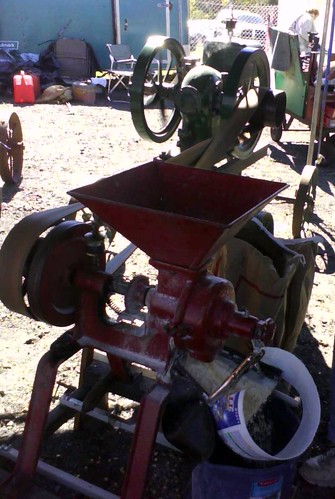On Saturday, the family and I went south to the Berlin Fair, an agricultural fair which has been sponsored by the Berlin Lions Club since the late 1940's and which is the successor to the Connecticut State Fair. That area of my little state - the region around Middletown, Meriden, and New Britian - still has a number of working farms and "backyard agriculture" and so there are plenty of old-fashioned exhibits like oxen pulls, poultry, cattle, food and craft competitions, and tractor pulls mixed in with the craftspeople, local businesses, and hucksters that are standard finds at fairs.
We tend to stay clear of the overly commercial "exhibits" and seek out the small, local, and unusual stuff. One such interesting display was put on by the Tobacco Valley Flywheelers, a group of antique engine enthousiasts who collect, restore, and maintain old gas and steam engines and machinery.
Among the number of one-lungers that were chugging away under their tent was a c.1910 McCormick-Deering engine driving a David Bradley corn mill. It was completely cool to watch sacks of corn being dumped in to the mill's hopper as medium-grind cormeal poured out the chute into a bucket. From there, volunteers were scooping the freshly-milled cornmeal into small paper bags and selling them for a dollar a bag. I bought two of them and used the cornmeal later to make delicious corn bread.
The small gas engines on display at the fair, and the cast-iron-and-steel machinery driven by them, represents an interesting period in New England farming history. At the time, much of the "bull work" on a farm - plowing, cultivating, hauling hay, harvesting, etc. - was done manually or with the help of animal teams like oxen or horses. Most farmers would bring grain to a centrally-located mill from processing, but small kits like this became more common as economical gas engines took their place on farms.
These engines, with their heavy flywheels, low RPM, and moderate horsepower, were used for a huge number of jobs on New England farms. They ran water pumps, grain mills, sawmills, machine shops, smithies, and more. Virtually anything you could run with a belt drive or crankshaft could be run by a hit-or-miss engine and they became a common sight in rural areas. Today, there are still thousands of them out there - some in the hands of collectors, who restore and maintain them - but many are still lying forgotten in barns, sheds, and shops waiting to be resurrected.
The small gas engines on display at the fair, and the cast-iron-and-steel machinery driven by them, represents an interesting period in New England farming history. At the time, much of the "bull work" on a farm - plowing, cultivating, hauling hay, harvesting, etc. - was done manually or with the help of animal teams like oxen or horses. Most farmers would bring grain to a centrally-located mill from processing, but small kits like this became more common as economical gas engines took their place on farms.
 |
| The David Bradley corn mill (foreground) grinding cornmeal. It's connected to the McCormick Deering engine in the background by a three-inch-wide leather drive belt. |
These engines, with their heavy flywheels, low RPM, and moderate horsepower, were used for a huge number of jobs on New England farms. They ran water pumps, grain mills, sawmills, machine shops, smithies, and more. Virtually anything you could run with a belt drive or crankshaft could be run by a hit-or-miss engine and they became a common sight in rural areas. Today, there are still thousands of them out there - some in the hands of collectors, who restore and maintain them - but many are still lying forgotten in barns, sheds, and shops waiting to be resurrected.


1 comment:
that sounds like some good cornbread!
Post a Comment